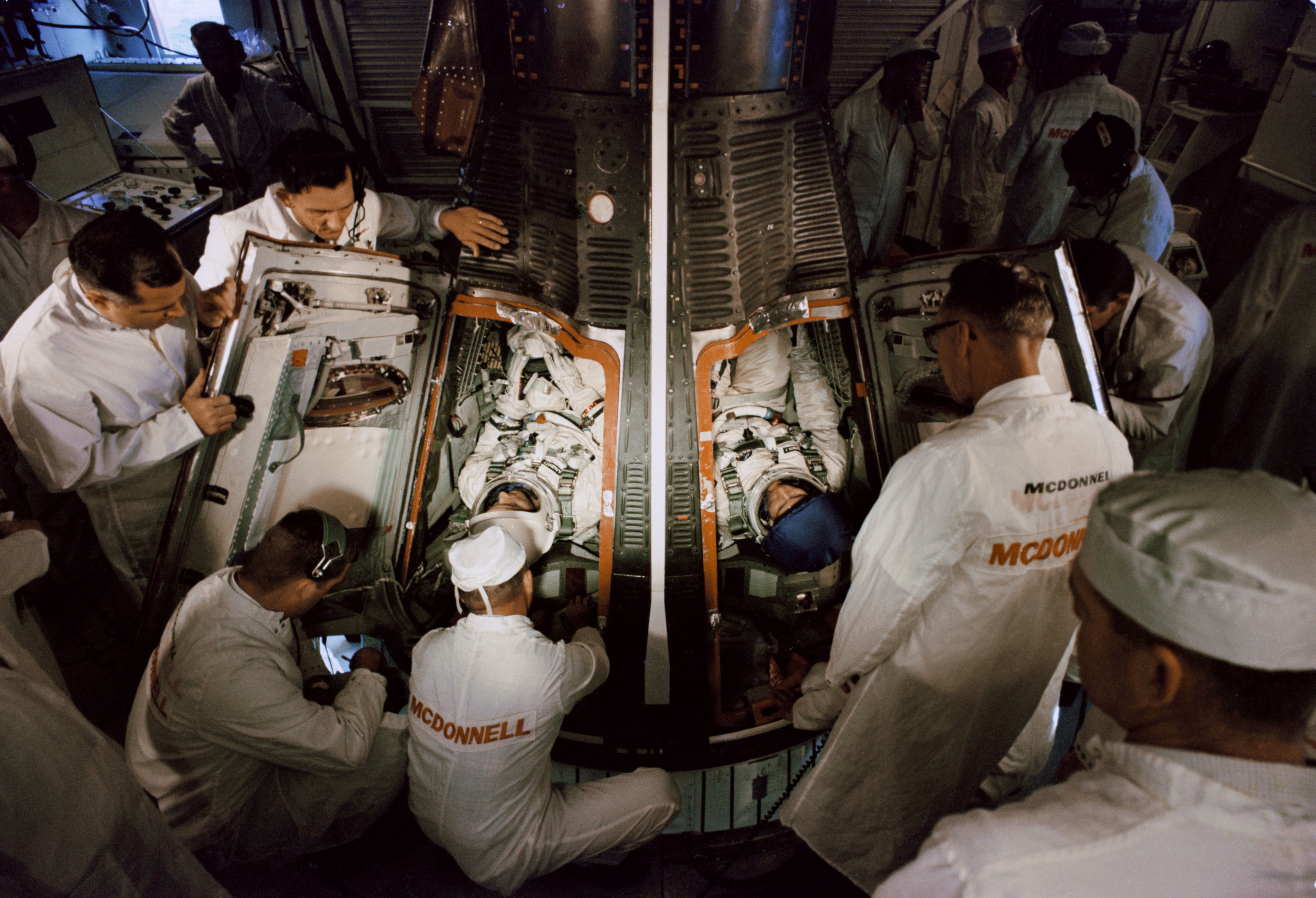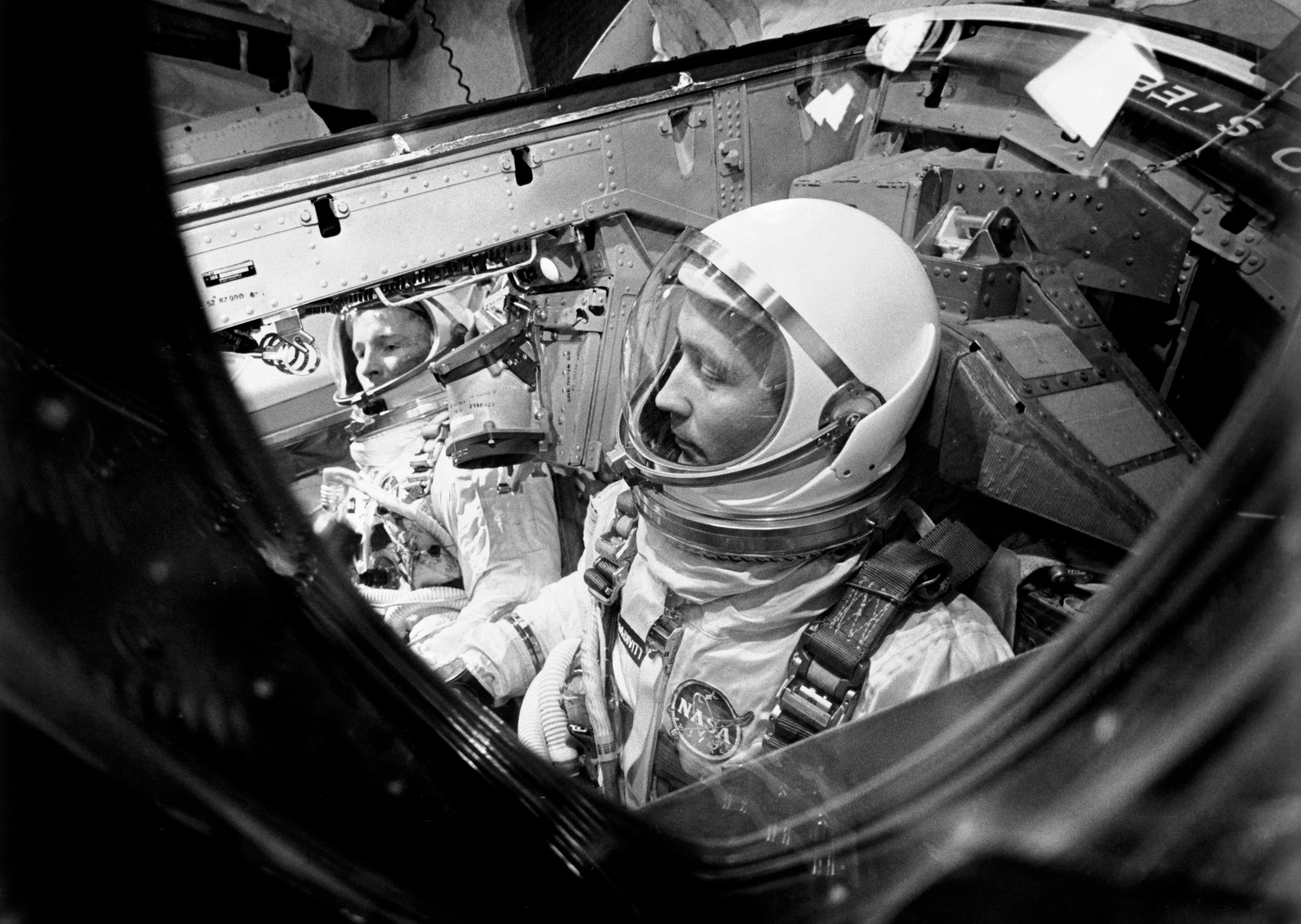
On this day, 3 June, way back in 1965, the United States took a huge step forward in its drive to land a man on the Moon. Aboard Gemini IV, astronauts Jim McDivitt and Ed White spent four days in orbit—longer than any previous American crew—and supported their nation’s first “spacewalk”. Neither accomplishment was a true “first”, for the Soviets had already done both, but for a relieved America the mission offered tangible proof that the lunar goal was in sight. McDivitt and White’s voyage is a case of being in the right place at the right time. When their names were announced in July 1964, Gemini Deputy Manager Kenneth Kleinknecht mentioned that one of them might perform a “stand-up EVA”, by opening the hatch and poking his head into the void of space. Yet it would take several months, and no small amount of lobbying by the astronauts, before such plans bore fruit.
As early as January 1964, NASA had flagged Gemini IV as the earliest possible mission on which to perform some kind of “extravehicular activity”, although at the time the availability of the required life-support equipment was uncertain. Throughout the year, the situation steadily improved, with AiResearch building an astronaut’s chest-mounted control pack, the David Clark Company making the space suit and McDonnell modifying its Gemini spacecraft to accommodate an EVA. When Gemini sailed through altitude chamber tests in November, the likelihood of an EVA brightened significantly. Efforts gathered pace in the wake of Alexei Leonov’s triumph and in mid-May 1965 Bob Gilruth, head of the Manned Spacecraft Center (MSC) in Houston, Texas, received approval to proceed from NASA’s top brass, including Bob Seamans, Hugh Dryden and Administrator Jim Webb.
There were concerns, however. George Mueller, the head of manned spaceflight, doubted that the EVA hardware could be ready in time for an early June launch, whilst Dryden was worried that the spacewalk might be seen as a knee-jerk reaction to Leonov’s achievement. At length, Webb asked Seamans to produce a report on why an EVA was necessary and on 25 May—with nine days remaining before the flight—Dryden scribbled his signature of approval on it. By this time, NASA had referred to a “possible extravehicular activity” in its Gemini IV press kit, released on 21 May. With the approval of Webb and Dryden, it turned from possible into positive…and it would not be a simple case of Ed White standing on his seat to poke his helmeted head into space; he would physically leave Gemini IV and maneuver himself around outside.

When the Gemini mission simulator became available in Houston in November 1964, McDivitt and White began actively lobbying for an EVA. It has been remarked that, without their tenacity, the “G4C” extravehicular suit might otherwise have been too far down the line to have been ready for Gemini IV. According to Barton Hacker and James Grimwood, writing in On the Shoulders of Titans in 1977, the astronauts’ role in the decision-making process “went far beyond that of the normal test pilot in determining what was to be done and when”.
Another primary goal was to increase endurance times, with a crew spending up to two weeks in orbit, to provide physiological and psychological data for a journey to the Moon. Gemini IV was originally scheduled to fly for seven days, but in August 1964 it was announced that problems and delays with certifying General Electric’s fuel cells would reduce it to four days. Before launch, McDivitt jokingly told journalists that there was only enough food aboard the spacecraft “for two normal people” for four days. Backup crewman Jim Lovell could not resist taking the bait; with perfect timing, he quipped: “And these two ain’t normal!”

Physical conditioning was critical for White and, during training, he spent 60 hours in vacuum chambers, rehearsing the opening of Gemini IV’s overhead hatch, pushing himself outside and moving around in a mockup space suit at simulated altitudes of 34 miles (55 km). In addition to his 22-layer suit, he would use a hand-held manoeuvring gun, equipped with two cylinders of compressed oxygen, to move around. Yet even in the final days before launch, there was scepticism in some areas of the press that this was little more than an attempt to keep up with the Soviets. At one press conference, Chris Kraft, the lead flight director, snapped: “We’re not trying to play Mickey Mouse with this thing! I don’t think it’s very fair to suggest we’re carrying out a propaganda stunt.”
Early on 3 June, McDivitt and White were awakened and began the process of medical checks, a steak-and-eggs breakfast, suiting-up and were at the foot of Pad 19 and their Gemini-Titan launch vehicle by 7:07 a.m. Since the EVA would require the depressurization of Gemini IV’s entire cabin—thus exposing McDivitt to vacuum, as well as White—both men underwent “pre-breathing” to flush nitrogen from their blood and avoid an attack of the “bends”. Their Titan II booster speared for the heavens at 10:16 a.m., to synchronized yells of “Beautiful!” from both astronauts.

The EVA required completion of a 54-item checklist, which concluded when White snapped a gold-tinted faceplate onto his helmet, hooked up the umbilical to provide oxygen and communications and McDivitt strapped the chest pack onto his torso. He checked his camera three times, making sure he had not left the lens cap stuck on. “I knew I might as well not come back if I did,” he later quipped.
Depressurization of Gemini IV’s cabin began over Australia, but hit a snag when White’s overhead hatch refused to unlatch. A spring had failed to compress properly. At length, four hours and 18 minutes after launch, he cranked a ratchet handle to loosen a set of prongs lining the opening of the hatch, raised it to 50-degrees-open and poked his helmeted head into the fathomless void. White then pushed himself “upwards” from his seat and caught his first awe-inspiring glimpse of Earth: the intense blue of the Pacific Ocean and, coming up to the east, Hawaii.

Losing no time, he tested the hand-held maneuvering gun and found that it responded crisply, squirting bursts propel himself to the base of Gemini IV and then to its nose. Within minutes, its gas supply was gone and White spent the remainder of his 21 minutes outside twirling, twisting and hand-pulling himself backwards and forwards along his tether. Inside the spacecraft, McDivitt had the difficult task of keeping Gemini IV steady. The long tether was also troublesome, as it kept tugging America’s first spacewalker towards the rear of the spacecraft, whose thrusters periodically spurted a nasty mix of monomethyl hydrazine and nitrogen tetroxide, which White definitely did not want on his suit.
Approaching the California coastline, Gus Grissom asked for photographs. “Get out in front where I can see you,” McDivitt called, and White complied. In less than a quarter of an hour, he had “walked” from the central Pacific, crossed California, and, very soon, the two astronauts were gliding serenely over Houston, talking to Grissom. Suddenly, McDivitt’s voice burst with excitement. “There’s Galveston Bay, right there,” he yelled. “Hey, Ed, can you see it on your side of the spacecraft?” White certainly could and promptly snapped a photograph. McDivitt was also taking pictures, although he admitted that “they’re not very good”. Ironically, those images of White, tumbling in space, turned out to be among the most iconic of the Sixties. A movie camera also captured his tumble, backdropped by a cloud-studded, blue-and-white Earth.
Each time McDivitt or White spoke, the Gemini’s voice-activated system cut off messages from Mission Control…and since they spoke a lot during those exhilarating minutes, Grissom had a hard time trying to contact them. At length, with some urgency in his voice, he made himself heard.

“Got any messages for us?” asked McDivitt.
“Ed! Come in here!” yelled Grissom. “Gemini IV, get back in!”
Describing the end of his historic EVA as “the saddest moment of my life”, White brought his feet back down through the open hatch, onto his seat and finally below the instrument panel. To assist his partner, McDivitt turned up the cabin lights as a guide. Gemini IV had sailed over the eastern Atlantic Ocean into orbital darkness and White had ‘walked’ across most of the Pacific and all of the United States…in 21 minutes. His last view was of the entire southern portion of Florida, parts of Puerto Rico and Cuba.
His pulse of 50 beats per minute, though, soared to 178 in these final moments. He closed the hatch over his head and reached for the handle to lock it, realizing that it would be as hard to seal as it had been to open. As White pushed on the handle, McDivitt pulled onto him to offer him some leverage. Eventually, the hatch was secured. The official end time of the first American EVA was 3:10 pm, some 36 minutes between hatch opening and closure…and less than five hours into Gemini IV’s four-day mission. White had far exceeded his suit’s cooling capacity—producing severe condensation in his helmet and sweat streaming into his eyes—and the hatch problems prompted Mission Control to tell him not to re-open it to discard unwanted equipment.

In his post-flight debriefing, White recounted that his hand-held maneuvering gun worked in pitch and yaw axes, but in roll it was more difficult, without using excessive fuel. He experienced no vertigo or disorientation, nor did he feel any inkling of the tremendous speed at which he was traveling. The next four days, however, would be anything but comfortable. The men remained in good spirits, although on one occasion McDivitt told flight surgeon Chuck Berry that he felt “pretty darn woolly” and needed a bath. When they returned to Earth on 7 June 1965, they were described as heavily bearded and sweaty, their faces lined with tiredness, although that did not prevent McDivitt from letting out a whoop of joy on the deck of the recovery ship Wasp.
Both astronauts had lost weight, but were in good physical shape after four days…to such an extent that, 24 hours after splashdown, White spotted a group of Marines and midshipmen having a game of tug-of-war and joined them for 15 minutes. Although “his” team lost, White certainly appeared fit and healthy. The need for a shower, though, was strong. “I thought we smelled fine,” White said of their distinct aroma, after four days without a proper wash. “It was all those people on the carrier that smelled strange!”






I believe that Gemini 4 marked the key turning point in the race to the Moon, something from which the Soviets never recovered. Had Ed White luved, he may very well have walked on the Moon.
In a way, the Crew of Apollo 1, Gus Grissom, Ed White and Roger Chaffee, ALL made it to the Moon with Neil Armstrong and Buzz Aldrin. A packet containing the Apollo 1 Mission Patch, a gold olive branch pin and Medal s Awarded to Soviet Cosmonauts Yuri Gagarin and Vladimir Komarov was dropped to the surface by Buzz Aldrin as he was ascending the ladder to reboard the LM at the end of the Lunar EVA.
You could even say that SEVEN Men made it to the Moon on July 20, 1969.
Fifty three years later and the Futuristic look of the GT-4 EVA images is STLL there and always will be.
Buzz Aldrin was right when he said the Stars and Stripes of “Old Glory” gave a Special Look to the pictures.